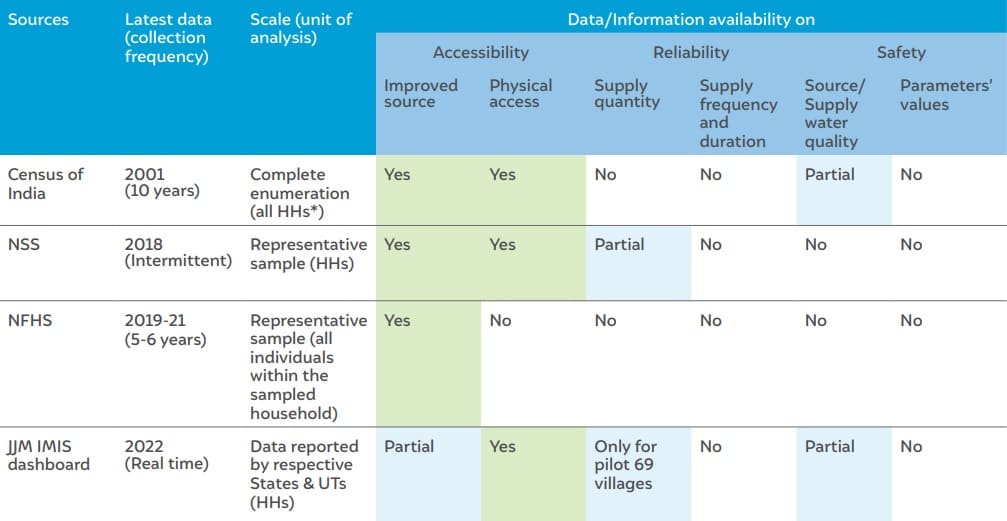In October 2022, more than 50 per cent of India’s rural households have a tap connection on their premises. The Jal Jeevan Mission, under which this expansion has taken place is targeting 100 per cent connections by 2024. Eight states and Union Territories (UTs) have already achieved tap water connectivity for 100 per cent of the households.
While the infrastructure penetration has clearly improved, is the drinking water supply ‘safely managed’ in rural India?
According to CEEW analysis, the proportion of rural households with access to an ‘improved’ drinking water source within the premises doubled between 2011 and 2018. However, this is the only comparable indicator from the available data sources across the years.
What are the current data sources on rural drinking water services?
Currently, four primary government sources report data on rural drinking water services in India — the Census of India, the National Sample Survey (NSS), the National Family Health Survey (NFHS), and the Integrated Management Information System (IMIS) Dashboard under the Jal Jeevan Mission (JJM). However, as these surveys fulfil varied objectives, they do not include comparable standardised indicators. Let’s examine what their current gaps are.
1. These surveys are undertaken with different frequencies and mandates. On one end is the Census of India, last undertaken in 2011, while on the other end is the IMIS Dashboard that provides data in real-time. Between these we have data from 2018 from the NSS, and 2019-21 from the NFHS.
2. The unit of analysis of these surveys is also different. While the Census, NSS, and IMIS measure data in households, the NFHS measures it in terms of population.
3. At the intersection of everything, there is no harmonious understanding of rural drinking water quality, as the indicators are not reported by all the data sources. This makes it difficult for policymakers and water quality managers to arrive at the steps needed to increase access to safely managed drinking water services in rural areas.
Table ES 1: Data and information provided by various national government sources only partially cover all components of safely managed drinking water services

Source: Authors’ analysis
Note: *HHs refers to households
Why do we need a standardised Water Quality Index?
As the Jal Jeevan Mission increases penetration of physical access to water infrastructure, the need arises to measure whether these services are ‘safely managed’ or not. India needs a comprehensive Water Quality Index (WQI) that can standardise the water quality data available from different sources, and succinctly report on the several water quality parameters currently used in the domain.
A WQI would provide a single score that helps classify source water quality as excellent, good, medium, bad, or very bad. These scores can then be used to monitor changes in water quality over time, and highlight areas that need further investigation. Moreover, standardised scores are easier to communicate to the public and have the potential to increase citizen engagement with issues in the water sector.
The use of emerging and existing technologies in water monitoring needs scaling and investment. For instance, the Internet of Things (IoT)-based smart water supply monitoring system piloted under JJM can be extended to cover household-level water supply and quality parameters.
‘Har ghar nal’, said the Centre in 2019 as it launched the Jal Jeevan Mission. Since then, the mission to put every household on the water grid has only gone from strength to strength. The question now is of the jal from the nal. The next steps in this journey come from robust data collection and making ‘quality of water’ the talking point when it comes to drinking water accessibility.
For the full list of recommendations, read our report ‘How Safe are Drinking Water Services in Rural India?’ here.
Poojil Tiwari is a Communications Associate at the Council on Energy, Environment and Water (CEEW), an independent not-for-profit policy research institution. Send your comments to [email protected]




Add new comment